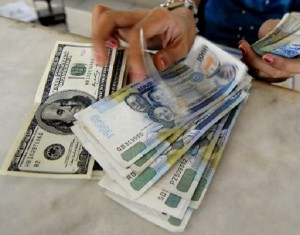Peso seen to continue weakening as dollar rallies
MANILA, Philippines–The peso is expected to continue to weaken in the coming months, with the dollar staying on its upward trajectory due to the sustained recovery of the US economy.
Bangko Sentral ng Pilipinas Governor Amando M. Tetangco Jr. said that while stable macroeconomic conditions would support the peso, the dollar’s rally was inevitable.
“We won’t go against the fundamental trend,” Tetangco told reporters, reiterating the central bank’s policy of allowing the local currency to move according to market forces, while reserving the right to intervene in case of spikes.
The BSP influences the peso’s value by buying and selling dollars in the foreign exchange market. To keep the peso from weakening, the BSP floods the market with dollars from its foreign exchange reserves. Doing the reverse has the opposite effect.
Monday will be the peso’s last trading day for the year. Last Dec. 23 or before the holiday break, the peso closed at 44.68:$1 versus the end-2013 closing of 44.395:$1.
Tetangco said that at the moment, the market was expecting a strong dollar, given the divergence of policy movements in advanced economies. Amid the American economy’s recovery, the US Federal Reserve is currently planning to tighten monetary policy settings for the first time since the start of the global financial crisis.
Other advanced markets, however, have gone a different direction. Central banks in both Japan and the Eurozone are still easing monetary settings to give their respective economies more room to grow.
“With this, some downward movement of the peso can be expected,” Tetangco said, noting that the improving conditions in the US would be a big draw for investors to get their hands on more greenback.
Tetangco said the BSP would be watchful of market conduct that could increase volatility in foreign exchange markets.
The central bank chief said there was a chance that investors might favor emerging market assets for a bit longer, helping support the value of currencies like the peso. The entry of investors into the country props up the local currency since foreigners need to convert their cash to buy local assets.
“There is the market view that given the Fed’s ‘patience,’ some more juice can be squeezed from the interest rate differential in favor of the emerging market bonds before shifting more aggressively to the US dollar,” he said.

